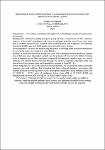| dc.description.abstract | Introduction: This section summarizes the objectives, methodology, results and conclusions of the study.
Background: Sufficient quantity and good quality of water is paramount for life. However, majority of the world’s population lack access to adequate and safe water. Every year, more than 3.4 million people die as a result of water-related diseases, and in Uganda, it is estimated that about 89,000 cases and 3,000 deaths occur annually due to cholera.
Broad objective: To assess the bacteriological quality of drinking water and associated factors at community water source points in Arua District.
Method: A cross-sectional study design was used, with Laboratory based experiment. Sample size of 140 was used. Dependent variable was the presence of the count of coliform forming units of bacteria on the filter membrane meanwhile independent variables were the hazard, pathway and indirect factors obtained through the sanitary inspection checklist. Data was entered into Excel spread sheet and imported for analysis to Stata/SE 15.0.
Result: Majority (70.71%) of the water sources had bacteria, the predominant isolated indicator organism was total coliform. The following risk factors showed statistical association with bacteria presence in drinking water source; drainage for wastewater being defective with aOR of 19.7[5.34 72.72], parts of appliances being loose aOR of 10.7[2.52 45.92] and defective/lack of fence aOR of 9.2[2.43 34.96] all with P-value <0.001.
Conclusion: Treatment of drinking water sources, regular water quality surveillance, cleaning, repairing spoiled appliance parts, fencing and repairing of spoiled fences among others to mitigate bacteriological contamination of water sources are required. | en_US |

